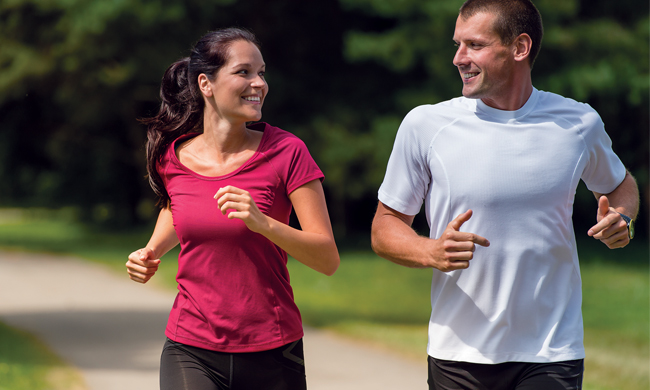HEALTHY LIVING
Top tips to get ready to run

(Family Features) You’ve made the decision to get in shape, and whether your goal is a full marathon or simply a few laps around the neighborhood, there are a few steps to consider taking before you strap on those shoes and head toward the finish line.
Here are a few tips to help get you ready for the big race:
Seek Quality Sneakers – Feet come in a variety of widths and sizes, so visit a specialty running store to find perfect-fitting sneakers. These may come with a hefty price tag, but there are no shortcuts for comfort and support while running long distances.
Make a Schedule – Try to aim for at least 10 hours of training per week, including three days where you run and two or three days of other physical activity such as cycling or strength training. To avoid exhaustion, be sure to include at least 1-2 “rest” days per week.
Stick with Water – Avoid sports drinks that are loaded with preservatives and sugars. You can’t go wrong with the hydrating power of water. As a rule, try to consume at least 6-8 ounces of water for every 20 minutes you run. Proper hydration after the run is also vital.
Go Online – Many websites have training guides for various skill levels or different types of races. If you have a smartphone, look for apps that can take you through day-by-day workouts to get you marathon-ready.
Nutrition – Filling your body with the proper amount of fuel can help ensure finish-line success. Load up on quality carbohydrates, such as beans, peas, whole-wheat pastas, whole-grain cereals, apples, brown rice and root vegetables. Protein also plays an important role in a runner’s nutrition, so fill up on lean meats, fish, eggs, low-fat dairy, peanut butter and soy protein sources, as well.
By following these general rules, you’ll be able to focus on achieving your goal and enjoy the thrill of finishing the race. Find more tips for a healthier lifestyle at eLivingToday.com.
Photo courtesy of Getty Images
SOURCE:
eLivingToday.com
HEALTHY LIVING
What women should know about their heart, kidney and metabolic health

(Family Features) Some women may be unaware they’re living with risks for heart disease, kidney disease and metabolic conditions like diabetes, which drive risk for cardiovascular disease.
The interplay among these conditions is called cardiovascular-kidney-metabolic (CKM) syndrome, according to the scientific experts at the American Heart Association. Consider these facts women should know about CKM syndrome.
Cardiovascular Disease is the No. 1 Killer of Women
Cardiovascular disease (CVD), which includes heart disease and stroke, affects nearly 45% of women ages 20 and older, and 1 in 3 women will die from it, according to the association.
“Despite heart disease being the leading cause of death for women, most women are not aware of their risk for heart disease,” said Sadiya S. Khan, M.D., M.Sc., FAHA, American Heart Association volunteer and a member of the science advisory group for the association’s CKM Health Initiative, supported by founding sponsors Novo Nordisk and Boehringer Ingelheim and champion sponsor DaVita.
Women may develop heart disease differently than men and experience symptoms uncommon in men. Women are more likely to have blockage in smaller blood vessels around the heart and, while chest pain is the most common heart attack symptom, women are more likely than men to experience pain in the arms, jaw and neck, too.
Early Action is Key
According to a study presented at an American Heart Association scientific conference, women with either Type 2 diabetes or chronic kidney disease are predicted to reach elevated risk for CVD 8-9 years earlier than women with neither condition while women with both conditions may reach high risk 26 years earlier.
Risk Factors are Connected
The health factors that comprise CKM syndrome are connected. They include high blood pressure, abnormal cholesterol, excess weight, high blood glucose sugar and low kidney function. If something goes wrong in one area, it affects others.
“Knowing your health numbers is critical to optimize your CKM health and prioritize prevention of heart, kidney and metabolic disease,” said Khan, who is also the Magerstadt professor of cardiovascular epidemiology and an associate professor of cardiology and preventive medicine at Northwestern School of Medicine.
Since high blood pressure and early stages of kidney disease and diabetes often don’t have symptoms, regular screening is necessary to be aware of your risk.
Pregnancy and Menopause Affect Women’s CKM Health
Each pregnancy is a window into later heart and kidney health, according to Janani Rangaswami, M.D., FAHA, professor of medicine at the George Washington University School of Medicine and Health Sciences and co-chair of the scientific advisory group for the American Heart Association’s presidential advisory that defined CKM syndrome.
Pregnancy complications such as pre-eclampsia, gestational diabetes and gestational hypertension are risk factors for future chronic kidney disease and cardiovascular disease, Rangaswami said.
Changes during menopause also influence long-term heart and metabolic health. This includes declining estrogen levels, increased body fat around the organs, increased cholesterol levels and stiffening or weakening of blood vessels, per the American Heart Association. Early menopause (before age 45) is linked to a higher risk for kidney disease, Type 2 diabetes and CVD.
“Women can mitigate those risks by getting appropriate treatment for their menopause symptoms,” Rangaswami said.
Social Factors Affect Women’s Health
Negative economic, environmental and psychosocial factors are associated with lower levels of preventive health behaviors like physical activity and healthy eating and higher levels of conditions like obesity and diabetes. Some factors affect women differently than men. For example, marriage is associated with worse health for women, and women are more likely than men to delay medical care because of costs, according to an American Heart Association scientific statement. Women are also more likely to have their health concerns dismissed, Khan said.
Women should know their risk and self-advocacy is critical. They should request thorough screenings that assess heart, kidney and metabolic health at visits with their health care providers. Visit heart.org/myCKMhealth to learn more.
Photos courtesy of Shutterstock
SOURCE:
HEALTHY LIVING
Rising risk factors: Heart disease remains leading cause of death

(Family Features) While medical advances have helped people live longer with cardiovascular diseases, many of the risk factors that lead to these diseases continue to grow.
Fueled by ongoing increases in high blood pressure, obesity and other major risk factors, heart disease continues to kill more people in the U.S. than any other cause, according to the American Heart Association’s 2025 Heart Disease and Stroke Statistics Update. In fact, cardiovascular diseases including heart disease and stroke claim more lives than all forms of cancer and accidental deaths – the No. 2 and No. 3 causes of death – combined.
According to the update, nearly 47% of U.S. adults have high blood pressure, more than 72% are at an unhealthy weight, nearly 42% are obese and more than half have Type 2 diabetes or prediabetes.
The annual report published in “Circulation,” the peer-reviewed, flagship journal of the American Heart Association, shows the prevalence of cardiovascular risk factors are projected to worsen over the coming decades.
“Although we have made a lot of progress against cardiovascular disease in the past few decades, there is a lot more work that remains to be done,” said Dhruv S. Kazi, M.D., M.Sc., M.S., FAHA, head of health economics and associated director of the Richard A. and Susan F. Smith Center for Outcomes Research in Cardiology at Beth Israel Deaconess Medical Center and associate professor at Harvard Medical School. “If recent trends continue, hypertension and obesity will each affect more than 180 million U.S. adults by 2050, whereas the prevalence of diabetes will climb to more than 80 million. Over the same time period, we expect to see a 300% increase in health care costs related to cardiovascular disease.”
Prevalence for major risk factors varies across sex and race:
- Black women had the highest rate of obesity at 57.9%, compared to the lowest rate of 14.5% among Asian women.
- Hispanic men had the highest rate of diabetes at 14.5%, compared to the lowest rate of 7.7% among white women.
- Black women had the highest rate of high blood pressure at 58.4%, compared to the lowest rate of 35.3% among Hispanic women.
The prevalence of these risk factors – obesity in particular – is growing among young people globally. As many as 40% of U.S. children have an unhealthy weight with 20% having obesity. Nearly 60% of adults globally have an unhealthy weight.
Long considered one of the leading preventable causes of death in the U.S. and worldwide, tobacco use is also trending down. Smoking rates have steadily declined among both adults and youth since the U.S. Surgeon General’s first report on the dangers of smoking from 51% of men and 34% of women in 1965 to 15.6% and 12%, respectively, in 2018.
To find the full report and more advice for healthy living, visit heart.org.
Photo courtesy of Shutterstock
SOURCE:
HEALTHY LIVING
Safe summer fun in the sun

(Family Features) Summer is the season of sun-kissed memories – backyard barbecues, sandy beaches, bike rides and late-night stargazing. However, the warmer months bring unique safety challenges that can catch active families off guard if they’re not prepared.
From sunburns to scraped knees and dehydration to bug bites, summer’s surprises don’t have to slow you down. With a few simple precautions and the right tools on hand – like reliable first-aid essentials – you can make safety second nature and keep your focus where it belongs: on making the most of every sunny moment.
Here are a few smart, easy tips from the experts at CURAD to help your family stay protected from the sun, heat, water hazards and the inevitable bumps and bruises from outdoor play.
Shield Your Skin from Harmful Rays
The summer sun can be harsh, making it important to take steps to prevent sunburn, even if it’s partly cloudy or overcast. If you plan to be outside for more than 15 minutes, apply a broad-spectrum sunscreen with an SPF of at least 30 before heading outdoors. Remember to reapply to all exposed skin – including overlooked spots like your ears, neck and tops of feet – every two hours, or more often if you’re swimming or sweating.
Wearing protective clothing, such as wide-brimmed hats, sunglasses and light, long-sleeved shirts, can also help shield you from harmful UV rays. When possible, seek shade during peak sun hours, typically 10 a.m.-4 p.m., to minimize direct exposure.
Be Prepared for Summer Scrapes
Accidents can happen anytime, especially during active summer days. Having a well-stocked first-aid kit, including bandages, antiseptic wipes and ointments, can help you quickly address minor cuts, scrapes and blisters.
It’s important to have the right bandages on hand for every situation. Bandages made with breathable and lightweight fabric and a four-sided seal are perfect for those hot summer days. While bandages infused with natural ingredients like soothing aloe vera, vitamin E and baking soda offer a fresh approach to healing.
Proven to aid in faster healing, hydrocolloid bandages, like those infused with aloe vera from the CURAD Naturals line, offer waterproof protection that helps cushion and seal out dirt and germs for multiple days. By sealing in moisture, hydrocolloid bandages help promote the optimal healing environment.
Keep the Fluids Flowing in the Heat
During the summer months, the heat can quickly lead to dehydration, which can cause dizziness, headaches and even heat stroke. Drink plenty of water throughout the day, even if you don’t feel thirsty, to stay hydrated. Aim for at least 8-10 glasses of water (8 ounces each) each day, or more if you’re going to be spending an extended amount of time outdoors or engaging in physical activities like hiking, biking or playing sports.
Keeping a refillable water bottle with you can make it easier to stay hydrated on the go and replenish the water your body loses through sweat. In addition to water, consuming hydrating foods like watermelon, strawberries, cantaloupe, cucumbers and bell peppers can help maintain your fluid levels and regulate your body’s temperature. Also avoid excessive consumption of caffeinated or alcoholic beverages, which can contribute to dehydration.
Keep Pesky Insects at Bay
Summer evenings are perfect for outdoor activities, but they can also attract mosquitoes, ticks and other pests. Protect yourself and your family by applying insect repellent on top of your sunscreen to all exposed skin and loose-fitting clothing. Reapply as needed, according to the instructions on the package.
Repellant fans, candles, torches and bracelets may be good alternatives to spray or roll-on insect repellants. Wearing long sleeves and pants, especially in wooded or grassy areas, can also help prevent bug bites. Remember to check for ticks after spending time outdoors and, if found, promptly remove them by using clean tweezers and pulling straight upward. Avoid twisting, squeezing or burning ticks, which can lead to the release of saliva or cause the head to break off.
Have Fun in the Water, Safely
Summer is the perfect time to hit the pool, beach or lake, but remember to prioritize safety while enjoying the water. Always swim in designated areas and never swim alone. If supervising children, ensure they are within an arm’s reach and wearing properly fitting flotation devices.
Avoid alcohol when swimming or supervising swimmers, as it can impair your judgment and reaction times, and be aware of your surroundings, including weather conditions and water currents. Enrolling kids in swimming lessons can also contribute to a safer experience in the water.
Visit Curad.com for more resources to help you safely enjoy your summer adventures.

Building Your Summer Scrape Kit
A summer first-aid scrape kit can be a lifesaver for those inevitable bumps, bruises and blisters. Keep your family’s kit in a waterproof case and in an easily accessible place, such as your car, pool bag or home first-aid cabinet. Make sure to keep it stocked with essentials for cuts, scrapes, burns, blisters and beyond, such as:
- Antiseptic wipes for cleaning wounds
- Antibiotic or antimicrobial ointment to help prevent buildup of bacteria
- Bandages like CURAD Naturals Hydrocolloids with Aloe Vera to treat minor cuts, scrapes and blisters
- Non-latex gloves to protect hands from dirt and germs
- Hydrocortisone cream for bug bites and rashes
- Sunscreen to help prevent sunburn
- Aloe vera gel for sunburn relief
- Water bottles to stay hydrated
- Ear drops for preventing or treating swimmer’s ear
- Insect repellent to help prevent bug bites
- Tweezers for removing splinters and pests
- Pain-relieving medications such as ibuprofen or acetaminophen
- Ice packs to help slow inflammation and reduce pain
- Thermometer tocheck temperature
- Other medications for allergies, nausea, congestion and more
SOURCE:
-

 NEWS2 years ago
NEWS2 years agoSuspect indicted, jailed in Tia Hutson murder
-

 NEWS3 years ago
NEWS3 years ago2 hurt, 1 jailed after shooting incident north of Nocona
-

 NEWS2 years ago
NEWS2 years agoSO investigating possible murder/suicide
-

 NEWS3 years ago
NEWS3 years agoWreck takes the life of BHS teen, 16
-

 NEWS2 years ago
NEWS2 years agoMurder unsolved – 1 year later Tia Hutson’s family angry, frustrated with no arrest
-

 NEWS2 years ago
NEWS2 years agoSheriff’s office called out to infant’s death
-

 NEWS3 years ago
NEWS3 years agoBowie Police face three-hour standoff after possible domestic fight
-

 Show us something good8 years ago
Show us something good8 years agoCountry music star children perform in Bowie






